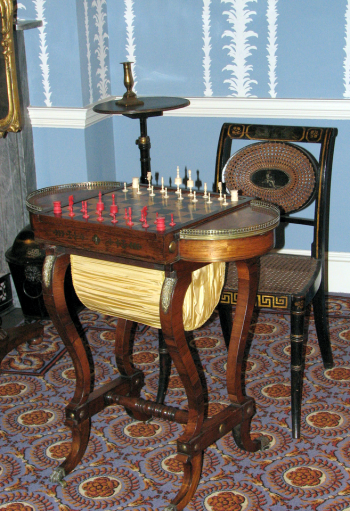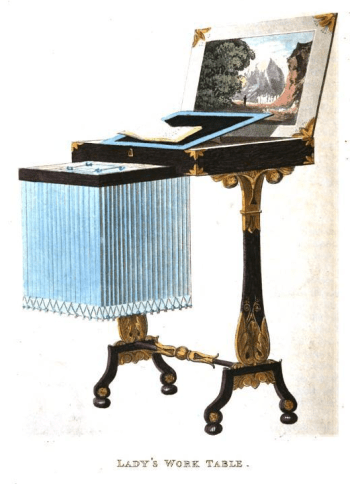
Before the 18th century ladies used to keep their needlework projects in a work-basket or bag. Then furniture designers started to create elegant little tables for the drawing room with a silk work-bag or box-holder hanging beneath. You have only to look at one to understand why Sheraton, the famous cabinet-maker, called his designs pouch tables.
As well as slide-out pouches to hold sewing materials, these small tables had drawers and compartments under a flip-up top. The owner wouldn’t always be sewing alone, though. Many kinds of fancy craftwork were done while families, or groups of friends, sat together. The novelist Jane Austen mentions a “work-table” used for “making a filigree basket” decorated with rolled paper quills.* Later in the 19th century a “Complete Guide to the Work-Table” offers instructions for “Berlin work, crochet, drawn-thread work, embroidery, knitting, knotting or macramé, lace, netting, Poonah painting & tatting”.
Various extras like a pull-out reading & writing slope and a chess board were common, and you could have an ink-stand, a backgammon board, and fold-down extensions. By 1800 many prosperous households had a lady’s work station that doubled as a play station. One 1815 table auctioned in 2001 (for over £4000) even had a zograscope built in; a high-tech optical toy by the standards of its time. More ordinary furniture of this type included many nicely-made needlework tables with a couple of drawers, a compartment under a hinged lid, but no silk bag. Some fine pieces defy categorisation, like this French porcelain-topped tulipwood veneer table from the 1770s.

American Federal or Empire work tables sell at auction for thousands of dollars; one made from mahogany and bird’s-eye maple in Boston around 1800 fetched nearly $20,000 in 2007. UK prices for Georgian and Regency tables vary a great deal according to quality: from hundreds to thousands of pounds. If you are buying, check any restoration work; newly-replaced silk pouches should be in an appropriate style.
Some rare European Biedermeier pieces are hardly tables at all, but globes opening to reveal perfectly crafted compartments for needlework tools and games pieces. Most of these elaborate neoclassical pieces were made, with great skill and fine veneer work, in Vienna or Berlin. Some drum-shaped work tables were made in this style, too.
A magazine in late Georgian London published a picture and description of a “fashionable” ladies’ work table in 1823. This suggests the idea was spreading out from the really wealthy and stylish upper class to more middle-class homes whose owners were interested in the furnishings of the upper social echelons. The writer of the piece quoted next probably thought readers would aspire to have a table like the one illustrated, instead of keeping their needlework in bags and boxes.

FASHIONABLE FURNITURE. Ladies’ Work-table –
This elegant table forms a pleasing and commodious appendage to the sitting-room of mansions fitted up in a style of superior elegance. It is equally adapted to the boudoir and drawing-room, and answers the purpose of a drawing-table as well as a work-table, and a desk for writing and reading. The silk bag suspended from the desk is, in the engraving, of azure blue, with silk fringe of the same colour, but should be made to correspond with the colour of the apartment for which the table is designed.In order that it may harmonize with the rest of the furniture, the frame-work should be formed of rose-wood of a rich dark colour, and varied in its grain. The ornaments are wholly of burnished and matt gold. The top of the table should be adorned with some rich design in water-colours, highly varnished, for the purpose of preserving it: this will be at all times a pleasing object to the eye. Fruit or flowers, well grouped, are particularly to be recommended. The interior may exhibit some pleasing landscape, or any other similar embellishment, according to the taste or fancy of the fair proprietor.
From: Repository of arts, literature, fashions &c, Ackermann & Shoberl, 1823
Photos
Photographers credited in captions. Links to originals here: silk pouch rosewood veneer work table, globe needlework table. More picture info here
Notes
* Sense & Sensibility
work table with sewing tools inside- do you sell this item I am interrested to buy
best greetings from Europe
Bernhard
LikeLike
Sorry – I just write about antiques – am not a dealer. Good luck with finding what you want.
LikeLike
It always amazes me how tiny the writing desks are, and the craft desks too, when the homes were vast! On the very few occasions that I’ve done any kind of craft work, I took up the entire dining room table and still wanted more room!
LikeLike
Yes, I know what you mean! I guess drawing-room crafts had to be fairly dainty.
LikeLike
Lovely article. I have a very pretty, early 19th century sewing stand that has a mirror in the lift-up lid (like the globe sewing stand in your article has). Could you tell me what the purpose of the mirror would have been?
LikeLike
Love your picture of the globe sewing table and located an antique globe sewing table, similar to the one you show, on http://ustar.cz/en/polozka-prodejni-galerie/rare-empire-globe-sewing-table/93, which is a Rare Empire Globe Sewing, Period: Vienna, approx. 1810, Material: blacken fruitwood, veneer, shellac varnish, embellished with three gilded Karyatidis and geometrical marquetry, see Biedermeier-Möbel, Rainer Haaff, 2006, page 79
LikeLike
Have you ever considered about including a little bit
more than just your articles? I mean, what you say is valuable and all.
But think of if you added some great photos or video clips to
give your posts more, “pop”! Your content is excellent but with pics and clips, this website could undeniably be one of the most beneficial in its field.
Amazing blog!
LikeLike
If you desire to get much from this post then you have to apply these techniques
to your won webpage.
LikeLike
Good info. Lucky me I came across your site by chance (stumbleupon).
I have book marked it for later!
LikeLike
Thank you for your informative and detailed website.
I’ve recently refurbished a particular table of which I’m not sure of its value or origins. I would love to send you a picture of it. I did find it amongst your grouping of the fifteen tables on your opening page, third row down and second from the left. There is actually three of the same style. I’m seeking information about its name and history. I hope you will be able to give me some details. Sincere Thanks, Deborah Robinson, Melbourne Beach, FL.
LikeLike
I love what you have done! thank you so much! as for the reader who wants more — some people just always have to criticize but what have they done?
LikeLike